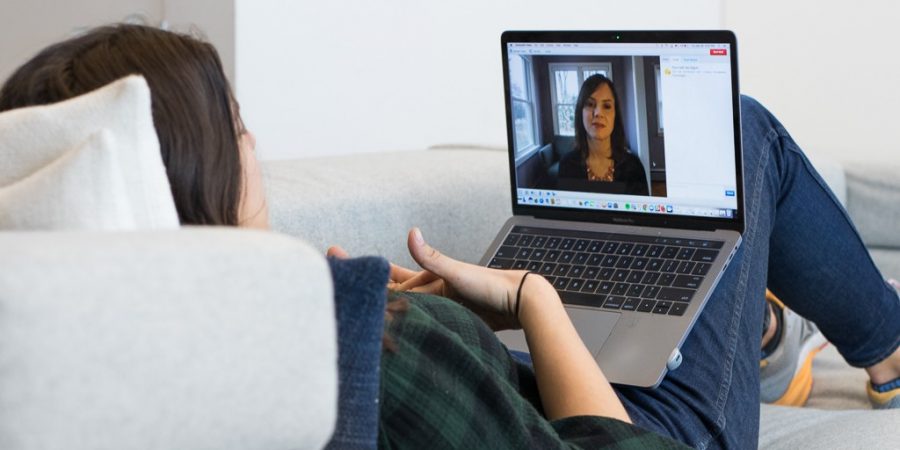Screen Therapy
For young adults who have struggled with mental health, the shift to online therapy sessions poses additional challenges.
Michael Hession/via Wirecutter
Therapy sessions, like all other social interactions, have gone online, increasing a host of mental health risks.
April 27, 2020
No one is having an easy time with quarantine. But the nationwide chorus of griping over lines outside of grocery stores and the tedium of homebound isolation can drown out a much more serious challenge that faces many of us in a socially restricted time.
Over one third of adults in the US have sought out some form of counseling for mental health, but over half of them will experience financial barriers when it comes to seeking treatment. Everyone reacts to stressful times differently, but there’s no question that isolation and social restrictions can wear on anyone’s mental health, especially for those who were struggling prior to the pandemic.
It’s hard to doubt that the number of people who may need to seek treatment for mental health is growing at this time, but the systems in place are barely enough to adequately support seasoned therapy-goers.
Mental health has shifted towards video chatting, as have most other aspects of our interactions with others. But web-based meetings pose many challenges and concerns for those who have been forced to turn their bedrooms into counseling offices.
“I don’t like having therapy at home,” said one NASH student. “Talking on FaceTime is difficult because there are so many more distractions. It’s easier to zone out.”
Dr. Angela Dean, a psychologist with UPMC Hillman Cancer Centers, noted that there are similar shifts from the professional standpoint as well.
“As [psychologists], we study human behavior and when interacting with patients, we often rely on eye contact, walking gait/ pacing, and body language to guide the interactions,” Dean said. “It’s how we gauge the responsiveness of our patients when discussing certain topics.”
Dean added, “Eye contact is nearly impossible with telepsychology, and in such a small frame, body language isn’t always visible. Sometimes patients are only able to attend sessions via telephone, making it even more difficult.”
The informality of online meetings may be difficult to overcome for young adults accustomed to a more professional atmosphere during therapy sessions.
“I find a lot of comfort in the formality of being in someone’s professional office,” a student from Quaker Valley High School noted. “Talking over FaceTime feels like I’m just talking to a friend.”
For Dean and her colleagues, the drawbacks of informality are felt on their end, too.
“I do understand feeling somewhat more relaxed when I’m working from home– like wearing comfy clothes and working from my bedroom– but it’s frustrating when things like testing and forms aren’t able to be completed,” Dean said. “It has also made it a lot more difficult to manage my time.”
Our homes are supposed to be a safe and private space away from the outside world, but they don’t exactly provide the privacy of a therapist or counselor’s office. Many sources I was in contact with mentioned their concerns about eavesdropping, or just generally inadequate sound barriers.
“While my house is a safe space, I feel a bit uncomfortable saying what I really want to say when I know my parents might hear me downstairs,” the QV student said.
Additionally, a Lafayette College student who is currently at home acknowledges that the absence of a private office can make a significant difference in the quality of a therapy session.
“The acoustics in my house make it easy to hear people talking at a normal volume from different floors,” she said. “I would be scared to broadcast my deepest insecurities to my entire family.”
But there are solutions to these hindrances as well. Dr. Dean made it a point to mention that people can call from a car or try going to a park if they fear being overheard.
“It can also be beneficial to purchase a white noise machine, or play white noise on a speaker near, or outside the door. It isn’t distracting and drowns out conversation for other people that who in the room,” she stated. “Some weird things do happen, though. If patients are sitting in their car in the driveway, sometimes they wave to their neighbors walking by.”
Dean recognizes that there are quite a few positives that come with being able to talk to patients from home.
“I finally get to meet my patients’ pets,” she said. “I recently met with a patient whose parrot sat on their head for a majority of the session. But there are also instances where people can attend group sessions together because their schedules finally line up.”
There is certainly a stigma surrounding mental health, though it can be overstated. 15% of people who have received treatment for their mental health said that stigma was a concern for them when seeking help. Yet an alarming 75% of people don’t seek the help they need because of this stigma.
Telepsychology has actually helped to mask the stigma.
“We can reach people now who would otherwise not come into the clinic,” Dean said. “We can see rural patients, or those who can’t get to the office because of transportation or health severity concerns. The stigma of going to see a psychologist is lessened because no one can see them walking in.”
But despite many hurdles being easy to overcome– the addition of a speaker or the lack of commute– therapy isn’t the fix-all solution to the quarantine nightmare.
“Forgive yourself. Permit yourself to find privacy when you need it, wherever it may be, create a new self-care routine. Try different healthy coping mechanisms that have worked in the past, or try a new approach,” Dean added. “Overall, allow yourself to realize it’s okay to not be okay all of the time. It’s okay to get help if you need it.”
Mental health is in now way something to push off for later, especially in times like these. The pandemic is a breeding ground for anxieties and insecurities that may only start to appear after weeks of isolation. Now more than ever, it’s important to put yourself and all aspects of your health at the forefront of your mind.
And even it that means scheduling an online meeting, there are steps you can take to do what is right for yourself.













